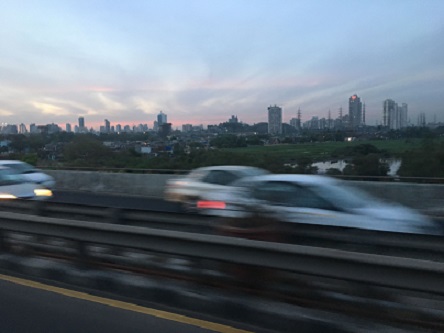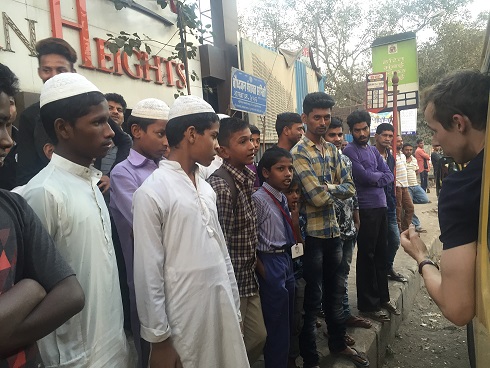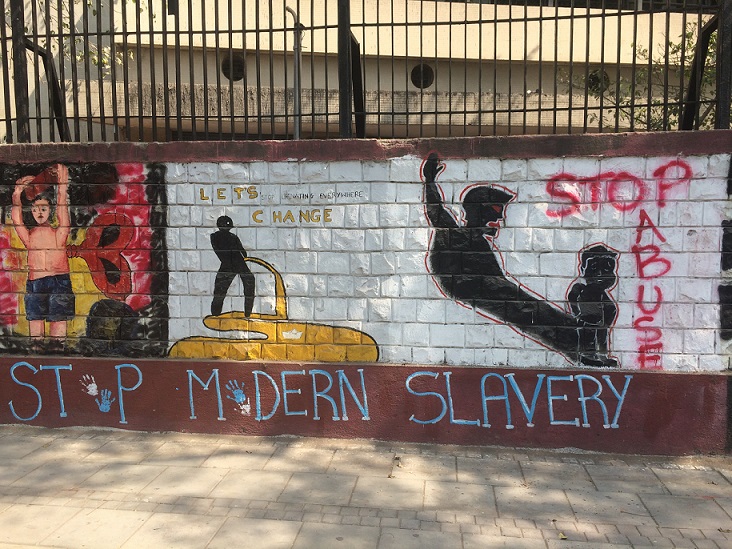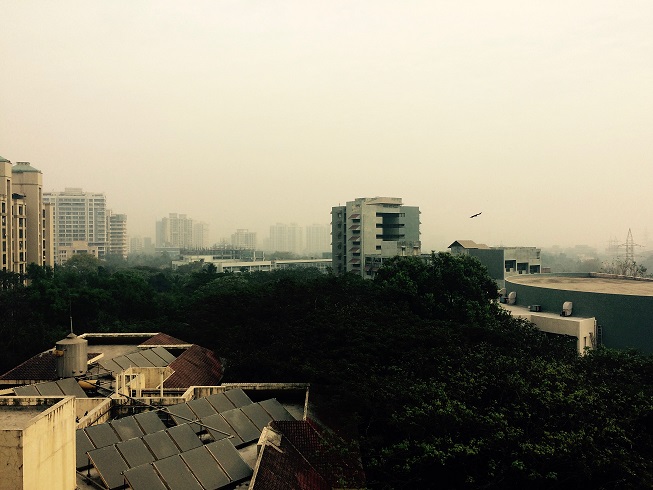By Jade Lisbin

Only 31 per cent of India’s population lives in an urban area. But this amounts to 400 million people. 23 million people live in Mumbai alone. With this exorbitant number of people, I wonder, how can technology be used effectively to improve the sustainability of a city, particularly a city like Mumbai?
In recent times, new cities in India have been built to replicate those in rich countries and incorporate technology. These are called ‘smart cities’. A smart city is generally described as optimising the use of Information and Communication Technology to monitor and maximise efficiency and increase the safety of all aspects of urban infrastructure whether that is schools, transport systems, shopping centres or waste management systems. The aim is to minimise resource consumption and costs in an attempt to make the city more eco-friendly and sustainable. In theory, this sounds like a great idea, right?
The problem with this model, as we learned from one of our Professors at Tata Institute of Social Sciences (TISS), is that rather than trying to improve an already existing city, private developers and consulting companies have started creating new cities on ‘uninhabited’ land. With this, comes environmental degradation, political corruption, further social exclusion and a whole realm of other issues. I can see similarities between this approach and the dominant consumer lifestyle in which it is now easier to buy a new product rather than fix an old one. This same approach is taken to the evolution of India’s ‘smart cities’. But it comes at a cost.
Lavasa is an Italian inspired, privately owned town built on the model of a smart city a few hours from Mumbai. It demonstrates many of the issues we have been learning about such as locking out the poor while creating new homes for the rich. Lavasa is an extreme example of the approach to urban planning. But perhaps there are alternatives. Rather than creating a whole new city, investment would be better focused on improving and rehabilitating local development plans within already existing cities.
From an ethical perspective, I find myself wondering why was it is okay for countries in the global North to use all the resources they like while putting pressure on countries in the global South, like India, to limit their resource use.
How do you envisage the future of India’s development? Do you see more ‘smart cities’ popping up around India?
Month: February 2018
Slum Tourism: An Ethical Dilemma
By Ben Robinson

“The locals are used to it. The main benefit is for tourists who change their perceptions” claimed our tour guide, Daksh, as we walked through the winding alleys of Dharavi.
On Sunday, I went on a paid walking tour of Dharavi, along with members of our group. Dharavi is India’s biggest slum with one of the highest population density in the world. In the week leading up to the tour, and since, there has been lively debate about the ethics of slum tourism. On one hand, there was a desire to see what we had been learning about in class, while also potentially benefiting the local community by providing funds to tourist operators. On the other hand, there were concerns it could be voyeuristic, invasive, and an aestheticisation of poverty. This raised a number of questions about the appropriate role of travellers within developing countries, and where the line lies between seeing things ‘first-hand’, and being intrusive.
The tour itself was informative and engaging. We were first taken through a commercial area, surveying a number of leather, textile and pottery industries, before going to a residential area then a local school, where 80 per cent of the profits of the guided tours are sent. Apart from small children who ran up to us, our interactions with locals were passive and detached. As one of many wide-eyed tour groups going through that day, there was a feeling of indifference toward us. Daksh, our tour guide, was excellent, but I left the tour wondering: was that experience necessary to get a holistic, balanced picture of what life in Dharavi is like?
I think part of our preconceptions about informal communities is formed because of the language we use to describe them. The terms ‘slum’, ‘informal’ and ‘squatter’ are problematic and negative, defining urban life in terms of a terms of a deficit. In economics, the informal economy is that part of the economy not accounted for in national accounts. The discourse of informality is framed as the ‘other’ within the formal economics framework and formal urban planning processes. But there is no sense in which informality precedes formality. Cities are built from informal processes as much as ‘formal’ ones. In India, 93 per cent of the economy is ‘informal’ and Dharavi has an estimated annual turnover of $1 billion.
I think the popularity of slum tourism, both in India and around the world, is also linked to a trope within western culture about the ‘authentic’ traveller who visits ‘exotic’ places and ‘gets off the beaten track’. Tourists construct a humanitarian Self through their engagement with suffering in developing countries. I’ve often heard stories where tourists present their travels as essential for coveted experiential knowledge while depicting locals as the true beneficiaries of the tourists’ self-discovery. While this may not have been exactly the case for our group, as we are here on a study tour, I think these cultural narratives do affect us.
All travel involves an element of voyeurism. We enjoy seeing new places and we grow from experiences that broaden our understanding of the complexity of the world. But reflection is needed when there is power dynamics between foreigner and local, when an experience is passive and observing, rather than active and mutually engaged.
There may not be definitive answers for Dharavi, or slum tourism generally. I think this depends on a balance between the actions and intentions of tourists, the views of locals about foreigners coming into their homes, and how the tour company operates within the community that they are profiting from. But, as a foreigner, I think there is a responsibility to be cautious, reflect, and be aware of the spaces you occupy.
Young India and the Pressure to Succeed.

I come from a Bangladeshi family and have always appreciated the family and community aspect of South Asian culture. This has given me a support network, spanning the globe, of extended family and friends who are genuinely interested in my wellbeing. But close community connections bring with them a number of expectations. For some young Indians family and community pressure has a devastating cost.
Youth suicide rates are higher in India than many other countries. Every year, 30-40 young people out of every group of 100,000 decide to take their own lives. Young people between the ages of 15 and 29, who have so much to experience, to love, to learn, have their lives cut short. One of the reasons behind this is family pressures.
According to National Crime Records Bureau (NCRB) data, 2015 saw 43,852 young Indians take their own lives, with almost 50 per cent of these deaths attributed to family or societal pressures. These pressures take many forms: secret love affairs, failure to marry, and even failure in exams. Notions of success have in many ways imposed unrealistic expectations on a generation that is struggling to compete in an increasingly hyper-competitive India.
Every year, millions of young men and women enter the job market, competing over the limited number of ‘regular’ jobs on offer. Only around 10 per cent of new jobs fall into the formal or organised sector. This has led to a phenomenon described by some scholars as ‘timepass’ where students remain in tertiary education for years while searching for employment. But as disappointment turns to apathy and discontent, this inability to secure to employment and marriage can lead to distress and in the worst cases suicide.
In a country where almost half the population is under 30, a ‘demographic dividend’ is expected to be a great boon to the economy. But the conditions of extreme competition and a culture of family and community expectation is having a terrible impact on many youth. Investment in mental health facilities are urgently required to address this national crisis.
Women and Public Spaces
By Myra Opdyke

Two things have surprised me during my time in India: men urinating in public, and the lack of women in public spaces. Travelling around, I have found myself in places where groups of two or more men are out with their friends. But until I got within a day’s drive of Mumbai I had not seen groups of women out with their friends. When I first came across a group of women out together, it wasn’t a group of two or seven, but a group of over twenty… safety in numbers, I suppose.
However moving in such a large group is not always practical, which brings me back the issue of open defecation. In class we have been learning about many aspects of Indian society, particularly the complex interactions of caste, class and gender and how they shape people’s individual agency. I have been particularly struck by how open defecation is a common practice in many parts of India. This means that women often wait until nightfall to relieve themselves. Under the cover of darkness they walk out of their villages and into the fields. But this can be a very dangerous activity. Cases of rape are common.
In some areas, public awareness about the health impact of open defecation is on the rise. One group of women have begun a movement whereby they refuse to marry a man unless there is a toilet installed at his house! Sounds like a great idea. I can’t help wondering, however, whether this is a bargain that most women are able to make. India, as we have been learning, is a deeply stratified society and women are rarely able to make such claims against prospective bridegrooms. When dowry deaths number in the thousands each year, it is hard to imagine that women are in a position to negotiate sanitation facilities.
When I arrived in Mumbai from my Northern travels, I was suddenly in a different world. It was a strange combination of the India I had seen so far, mixed with British colonial buildings and women walking around freely. In some ways, I felt like I could almost be back in Sydney. It is the smells that set Mumbai apart. For a stretch of half a block, you may be smelling spices, flowers and fruit. But in a moment, you find yourself suddenly inhaling the smells of urine, defecation, and rot.
In India, a city can feel foreign compared to the surrounding rural areas. While some women in the city eat at fine dining restaurants, others are risking their lives as they walk to a field late at night. On this peaceful evening, gazing out of my seventh story window as the sun sets over the slums, greenery and multi-story buildings nearby, I can’t help but wonder how the women of Mumbai city are living. I wonder how their different backgrounds have converged to bring them here, and how the city will treat their daughters.
A Clean Green India for Who?
By Jennifer Horton

If you ever find yourself waking up on the seventh floor of the Tata Institute in Mumbai, this is what you should expect to see. Today’s weather forecast, ‘hazy’. Tomorrow’s — ‘cloudy’. After that, ‘smoky’. You get the picture.
Down on the ground, the situation is no better. Traffic controllers arm themselves with black face masks. Congested roads fade into a hazy mist. As Mumbai’s smog levels creep higher and higher, the question of how to reduce dirty emissions from vehicles is becoming increasingly difficult to ignore, for citizens and government alike.
Earlier this week, the Maharashtra government revealed its plans to address the issue of pollution — through a comprehensive electric vehicle plan. The Cabinet has cleared a new policy that encourages the manufacture and use of green vehicles through tax rebates for electric car buyers, financial incentives for manufacturing companies, and subsidies for new charging stations. Owners of electric vehicles will be exempt from road tax and registration fees, and offered a subsidy of up to 100,000 rupees. The government claims that the new policy will create 100,000 new jobs within the state. For greenies and climate activists alike, this sounds like a dream come true, right?
There is no doubt that electric cars are a useful strategy for reducing vehicular emissions. If every car and bike in India were replaced with an electrical equivalent, the transformation would be unprecedented. Smog could be a thing of the past. In India’s goal to go completely electric by 2030, it’s a bold step.
But I can’t help but wonder — of all the bold government steps that India is in need of it, is this the right one? Electric vehicles look good on paper. But looking out this window, it’s hard to agree this policy is adequate. At best, it’s a signal of the government’s decision to prioritise environmental action. At worst, it’s yet another example of government policy that perpetuates inequality in India. What sense does it makes to subsidise electric cars, if the roads they’re driving on are riddled with pot holes and lined with slums? Why should 100,000 people get cheap Teslas when millions of others are still vying for plumbing?
Last week, I would have jumped at any proposal designed to promote electric cars. They’re clean, they’re efficient, (most importantly) they look cool. But after a few days of walking the streets of Mumbai, I’m struggling to summon any enthusiasm for a policy that seems to disregard the needs of so many millions of Indian citizens, to whom electric cars are a distant dream. There is no question that improving air quality and reducing emissions should be a government priority. But the introduction of electric vehicles won’t stop the huge amount of biomass burnt by slum-dwellers, nor will it reduce the enormous emissions from India’s coal and oil power plants. Electric cars are a fantastic tool for clean energy — provided they come hand in hand with energy policy that meets the needs of Indian society beyond the richest 10%.
Reading about India’s environmental policy back home, I never considered it in relation to the growing divide between India’s have and have-nots. But being here now, it’s clear that any steps taken by the Indian government to address pollution must be taken as part of a larger mission — to reduce India’s crippling inequality. At its heart, getting rid of smog isn’t about reducing carbon footprints, meeting climate action goals or creating a cleaner planet. It’s about improving quality of life for the citizens of India. Looking out at the streets of Mumbai, it’s pretty clear that the citizens of this country are in need of a lot more than a few cheap Teslas. Electric vehicles will undoubtedly play a significant role in reducing vehicular emissions sometime in the future. But right now, let’s not forget whose future we are talking about when we speak of a clean future for all of India.
Not the Gateway to India I had envisaged
By Alexander Vaughan
Arriving in Mumbai I was truly surprised. I had heard that Mumbai was a lively, cosmopolitan city, with disorganised traffic, Bollywood and ever-growing wealth disparities. But on exiting the bustling Chhatrapati Shivaji Terminus (CST) in the Fort district, I was surrounded by Victorian gothic architecture. I found it hard to believe I was in India and not wandering around Europe. I have a basic understanding of Indian history, and have read of the influence of the East India Company and the British Raj, but I did not expect to see the colonial influence in such an overt form.
Near to CST are the hustling markets which I had anticipated, with locals exchanging rupees for cheap and delicious pav bhaji, onion pakora, samosas, masala chai and a widespread selection of local fruits and vegetables. Around me buildings are crumbling, streets are chaotic and rubbish piles up. Temples, mosques and various national monuments rise tall. The call to prayer from the local mosque is a low hum. Vibrant Hindu and Islamic dress are in abundance.
But it is the influence of the British which really takes me aback. Having travelled briefly in the South of India I find the British influence in Mumbai stark by comparison. The architecture, the language, government and educational system, the transport infrastructure and cricket are all on display and tell the story of colonialism.
But India is not simply a cricketing nation and a democracy based on the British system undergoing rapid development. The Republic of India has only existed for 70 years and is a federation of States with different languages, customs and ways of life which lay within boundaries drawn up at Independence. Behind the visual façade I encountered when I exited CST lays a culture with deep rooted systems and customs, which have existed on the sub-continent for thousands of years.
In our classes so far we have been introduced to the intertwined structures of caste, class and religion and the role they play shaping Indian society. Progress is complicated. Women have less opportunities and face structural hardships. Adding to the intricacies of Indian culture and its many sub-cultures, is the sheer scale of India – how to manage 1.3 billion people?
I need to remember that India has a dynamic and contested history, and that the learning we are receiving inside and outside the class is embedded in this history. I expect the field school will peel away a few of the layers, make things clearer, and organise a few pieces in the greater puzzle that is India. There is so much to learn and consider. I am excited and everyone in the group is engaged.
Political Economy and geography students start Indian field school

On Monday, 17 students majoring in political economy and geography arrived in Mumbai for a three week intensive field school experience. The field school is run by the Department of Political Economy and Geography in collaboration with three Indian universities/research institutions: the Tata Institute of Social Sciences (TISS), the Indian Institute for Health Management Research (IIHMR), and the Central University of Karnataka. The field school involves an intensive, integrated three-week program of classes and field visits addressing the political economy of development and environmental management in modern India. Students are engaged by Indian scholars and civil society groups working on issues of geo-political, economic and environmental importance and gain firsthand insight into the daunting challenges facing one of the most important nations in the contemporary global economy.
The first week of the program will be run at the TISS campus in Mumbai. Students will stay on campus at the Tata Institute of Social Sciences and participate in tailored classes and city field visits developed by the local academic staff, in close collaboration the University of Sydney convenors. This component of the field school will address India’s ‘national story’ of development, and raise questions about the contested process of economic development, environmental sustainability and social inequality.
In the second week of the program, students fly up to Jaipur in Rajasthan. Here they will stay with our partner organisation, the Indian Institute for Health Management Research. The IIHMR has specialist expertise in the delivery of social programs to poor and remote rural parts of India. This week’s program will provide an opportunity to see rural India firsthand and will include day trips to local villages and national parks where ystudents will begin to develop a critical appreciation of the contested relationship between economic development, human security and ecological sustainability.
The third week of the program takes us to Hyderabad where students will drive a few hours out to the Central University of Karnataka, in the regional city of Gulbarga. In this part of Northern Karnataka students will be exposed to some of the most pressing issues facing Tribal communities in India, and their efforts for political and economic security within a rapidly modernizing global economy.
The blog posts that follow will capture the student experience of contextualized learning and their reflections.

